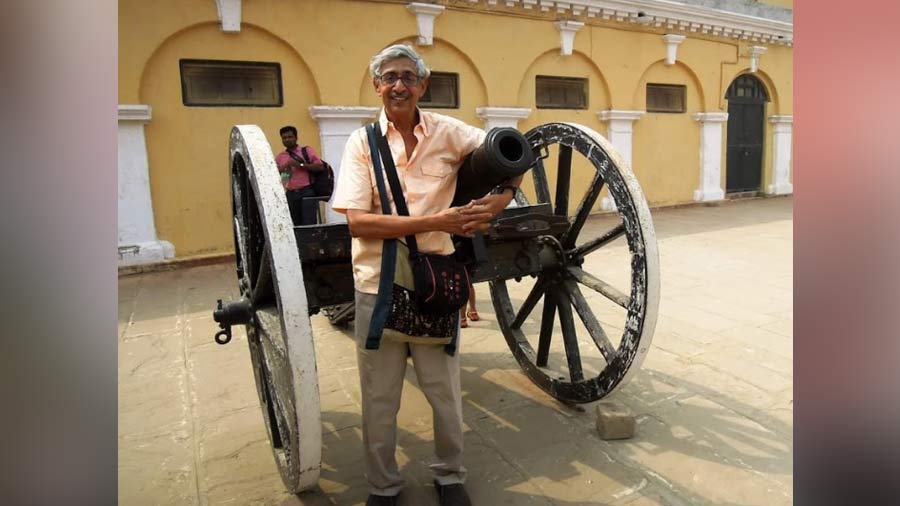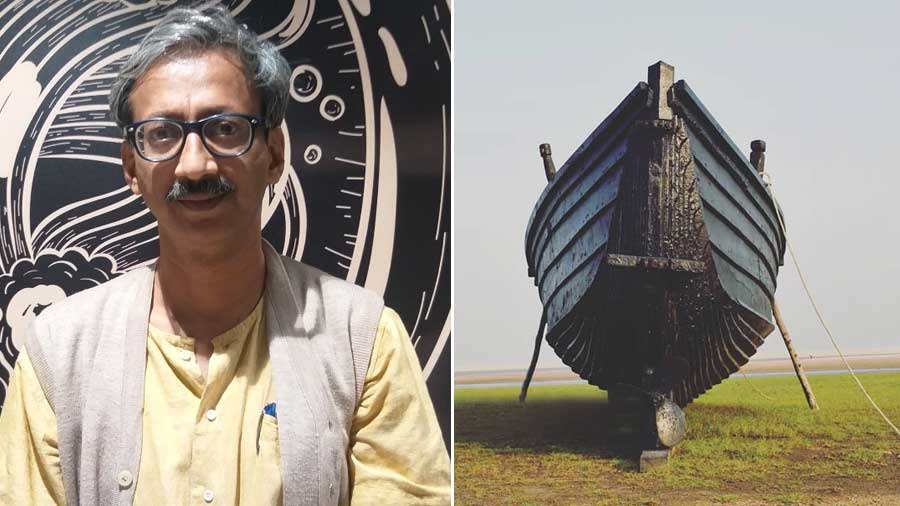A boy who played with toy guns like most others his age and, being a student of the Air Force School in the airport area of Barrackpore, often wandered inside the army air base, the Police Training School, Barrackpore Rifle Club and cantonment areas, grew up to nurture and avid interest in arms and artillery.
At 71, Amitabha Karkun is like any other senior citizen, but his passion for documenting and studying the history and technology of cannons as a firearm has made him somewhat of an expert on the subject though he has never academically studied it.
“As a kid I was happy to play with toy guns and growing up in the cantonment town of Barrackpore in the early 1960s, when the place was yet to be burdened with ugly urbanisation of today, helped me have a great exposure to it,” said Amitabha, sitting in his cosy south Kolkata home.
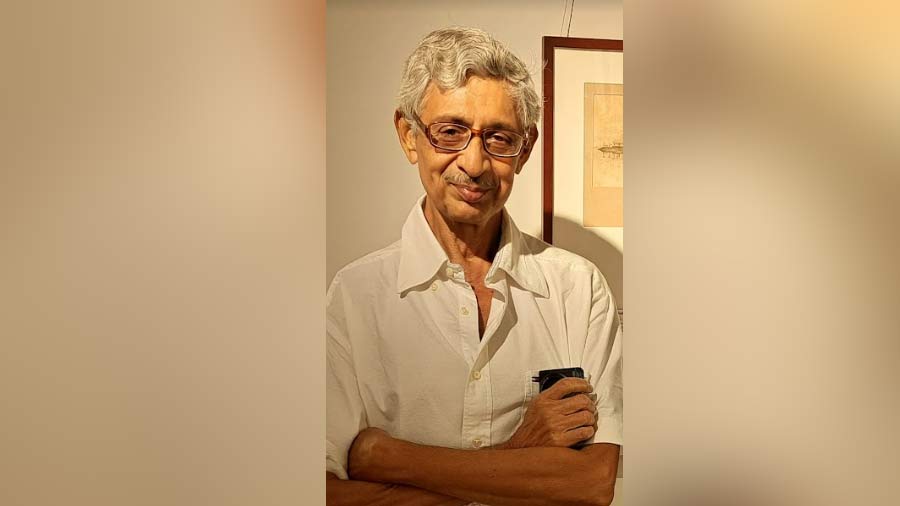
Amitabha grew up in the cantonment town of Barrackpore and was a student of the Air Force School, which sparked his interest in artillery and war history Somen Sengupta
In those days, he recalls, “there was hardly any restriction for common people”. So, from the early stage of his teens he got to see and was even able to touch aircraft like Gnat, Hunter, Vampire, and many more, generating a profound curiosity on military warfare.
Witnessing a war
The Indo-Pak War of 1965 changed Barrackpore and also Amitabha simultaneously.
He recalls the Pakistani air raid in mid-October, when he saw one DC-3 Dakota and a Fairchild Packet aircraft bombed in front of his eyes and he also saw two US-made Pakistani fighter bomber F-86 Sabres.
“It was an experience of a lifetime and it made me more inquisitive to know how these enemy aircraft were not detected by our Russian radar installed at the Jaffarpur air base and also by two combat air patrol aircraft of the Indian army,” Amitabha said with boyish excitement. In the 1971 war, seeing huge deployments of the Indian Army at Barrackpore and the secret training camps for the muktijoddha near his house ignited his interest even more in the subject of warfare. However, he soon left Bengal for his studies and then began his working life that blocked him away from digging into the subject further for many years.
“My passion flamed up in the late 1990s when I came back to Calcutta and started visiting places like Victoria Memorial Hall, Indian Museum, National Library and Cossipore Gun and Shell Factory. The world of the Internet took my wisdom to a new level through many rare documents and articles on firearms loaded with technical and historical data.”

With the cannon of Ranjit Singh that was taken over by the East India Company after the Anglo-Sikh War Courtesy Amitabha Karkun
Captured by cannons
Amitabha retired in 2001 and by that time he was fascinated by the study of cannons. He started exploring known and unknown cannons, kept mostly in neglected states, across Bengal and other corners of India. Soon, from many of those cannon he gleaned little-known information that added a new insight to the subject.
So, what does one know from the study of cannons, asks Amitabha before giving the answer himself — it is more a knowledge of science than chronology of history, he says. “Every generation of cannons actually scripts the scientific advancement of its time and it shows how over time, technology pushed man to create more deadly weapons — both for conquest and for self defence.” He has observed that many cannons of the world were made not to use but to show off the might of the ruler and most of the gigantic cannons were not fired a single time . “The best example of this is the huge cannon at the Jaigarh fort of Rajasthan or even Dalmadal, Bengal’s most celebrated cannon that is now in Bishnupur town”.
Mobility is a big logistical challenge for cannons, so bigger the size of the cannon, smaller its chances to be on the warfront. In those cases, the cannons were installed at forts or palaces to create panic among invaders, added Amitabha.
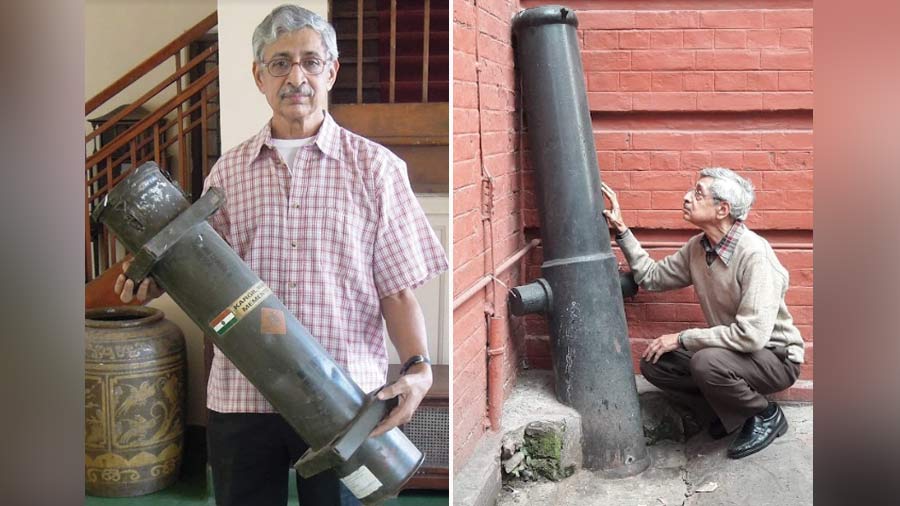
Holding the shell of Bofors cannons and (right) inspecting a cannon at the Indian Museum Courtesy Amitabha Karkun
“There would be no Mughal empire in India if Babur had not used cannons in First Battle of Panipat in 1526 and Akbar would not be able to have a kingdom so vast if he had not implemented the European art of making cannons.” Amitabha references Abul Fazl’s Ain-i-Akbari, which mentions implementation of various cannons in the Mughal army. From the time of Shah Jahan, the importance of developing firearms started reducing and it finally culminated in the fall of India’s longest foreign rule. Amitabha adds that the cannon used in the 1526 war had a rapid fire frequency of maybe once per hour while cannons used in 1838 Anglo-Afghan War had a rapid fire frequency of sixty per hour. “Thus is the progress of technology.”
The stars of the cannon show
Studying cannons has helped Amitabha identify and differentiate between the make of the unique object — whether it is cast iron, wrought iron or welding iron. The inscriptions and emblem give him an idea of its makers and the size and shape help understand the purpose of its making, whether it is for use or just for display.
To his surprise, Amitabha found out that in the business of cannons in Europe, the best brains were those who used to make church bells and were the ones primarily involved in cannon making. In 1716, an English Army soldier and engineer named Albert Borgard, oversaw the standardisation of design for artillery and arms fixing designs for artillery pieces, gun barrels, etc. However the skill was soon mastered by Turkish and Parsians who contributed immensely in Indian cannon making from the 16th century.

The cannon at Jaigargh fort, Rajasthan Somen Sengupta
Among the many cannons Amitabha has seen in India, some stand out. “I must mention the 4.36-metre-long and 1549-made Malik–e–Maidan cannon now placed in Bijapur fort, and also the 4.6-metre-long Fateh Rahbar cannon of Golconda fort. Both are extraordinarily exceptional works of iron and bronze casting showing the highest skill of Indian cannon making. In Bijapur, the Lamchari cannon of 1538 is another object to wonder with. It is 9.32 metres long and so far one of India’s biggest cannons found”.
The cannons of Bengal
When talking about the cannons of Bengal, Amitabha has many anecdotes to share.
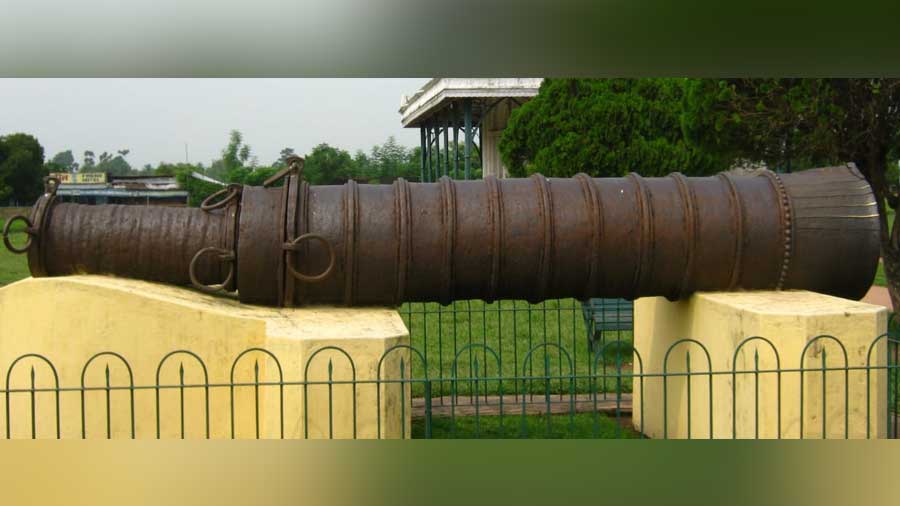
Bacchawali Tope, Murshidabad Courtesy Amitabha Karkun
Every single tourist guide and even some books will tell you that the Bacchawali Tope of Murshidabad is named so because of the myth that its booming sound was so powerful that it would cause abnormal abortions in pregnant women nearby. According to Amitabha, however, there might be a different reason behind the name. The cannon has two separate channels on its back — one for stuffing gun power along with space to push it deep inside. This makes the rear part of the cannon channel look like a small cannon inside of the womb of the main cannon. “Thus, it is lovingly called the ‘pregnant cannon’”. As per him, it was also never fired in Murshidabad after being taken from Malla kingdom.
The other nugget of information is about an infamous cannon. “How many of us know that the Bofors cannons were used in both the 1965 and 1971 wars, much before it earned a bad name due to a scam in 1986? All those were made in Cossipore with foreign technological inputs,” he said.
The Dalmadal cannon of Bankura is another one that Amitabha is amazed about, especially its manufacturing technology. “It is made of 63 concentric iron rings and each of those rings have three parts. They all were wielded when the iron was too hot with continuous strokes of hammering. The external surface of the cannon still contains incalculable marks of hammers and it was a hell of a job in those days,” he explained.

A bronze-cast canon from Maharaja Krishnachandra's era at Victoria Memorial Hall Courtesy Amitabha Karkun
Bengal’s Jahan Kosha is an extremely beautiful cannon with its ornamentation and inscriptions, which have now faded as a result of tourist tyranny. However, the best cannon he has found is at Victoria Memorial Hall.
“It is a cannon of Raja Krishnachandra of Nadia and was made by an artist named Braja Kishore Das between 1728 to 1782,” said Amitabha. He adds that he was amazed to know later that Lord Curzon, the mastermind behind the making of Victoria Memorial Hall, collected the cannon from the royal family of Nadia.
“We must be grateful to Lord Curzon, for keeping 25 rare cannons of India for preservation at Victoria Memorial, a monument he planned and executed but never saw after it was completed.”
“I later found another similar looking canon at Behala Archaeological Museum, also made by Braja Kishore Das in 1740 for one Raja Jaswant of Mangalkot.” According to Amitabha, this is the only instance that an Indian city has two different cannons made by the same person for two different royals. “It is amazing!” he exclaimed.

Inspecting an unmarked cannon at the south gate of Victoria Memorial Courtesy Amitabha Karkun
Protecting history
Amitabha Karkun, the man behind the renovation and restoration of several colonial heritage buildings of Barrackpore under the West Bengal Heritage Commission, has one regret.
From 1995, he has been trying to convince the management of Victoria Memorial Hall to properly tag and document several arms and cannons lying in the most unimpressive states inside the central hall. “It was never taken seriously and now those objects are removed from the central hall,” he added. However, he is happy that on his push and request the famous canon of New Market, which was once used in the Boer War, is very nicely preserved though it was removed from its old place to save it from vandalism and bird droppings.
“The study of arms, especially cannons, must be a subject of serious academics but in India that cult is yet to be started,” says Amitabha, while adding that he is happy that things are slowly changing and the Gun & Shell Factory of Cossipore, the Calcutta Police Museum, etc have opened their exhibition halls to the people.
“This will change the picture,” he said, smiling, while thumbing a small clay model of Dalmadal placed on his study desk.
